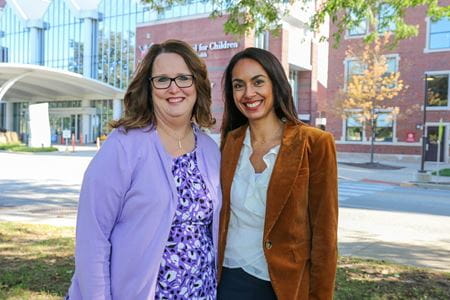The Cure Glomerulonephropathy Network (CureGN) study has been enrolling patients since 2014 with over 68 clinical subsites across the United States, Canada and Europe. Pediatric Nephrology’s study site at Riley Hospital for Children is the only site in Indiana and is one of the highest enrolling children’s sites study-wide.
Myda Khalid, MD, associate professor of pediatrics at IU School of Medicine, and Sherry Wilson, RN, lead Riley Hospital’s study site for CureGN. They’ve been involved in the study since inception eight years ago and have been consistently recognized as one of the top retainment sites for the study.
CureGN’s ultimate objective is to cure glomerulonephropathy. Glomerulonephropathy is a disease of the glomeruli, which are the tiny tubes deep in the kidneys responsible for filtering water and wastes in the blood. Glomeruli are what we commonly associate with the “function” of our kidneys.
The CureGN study follows four GN disease paths: minimal change disease (MCD), focal segmental glomerulosclerosis (FSGS), membranous nephropathy (MN), and IgA nephropathy (IgAN or IgAV). These diseases are extremely rare but serious conditions, especially in children where yearly incidences of these diseases are about 5 to 10 cases per 100,000 people. The rarity of these disease makes it difficult to know why they happen, and how best to treat them. CureGN hopes to change that.
This study follows patients longitudinally from the time of their enrollment throughout the life of the study. Riley is a unique center because while all the patients enrolled were children at the time, the team will continue to see them even once they mature and “outgrow” a children’s hospital. While some centers have strict age limitations to who can be seen there, Riley is allowing study patients to continue being seen. They have patients that have matured, gotten married and even had their own children.
The data collected during study visits includes blood and urine samples that reflect disease activity, medications, and most importantly data on the patient’s quality of life in hope that doctors can evaluate and find information to regiment the course of treatment and provide that information to new patients being diagnosed. In the last 3 years, Khalid has published 3 papers in collaboration with the study with more papers in progress - introducing new data about children with glomerular diseases to the scientific community.
“The patients are really excited to be helping in any way that they can...And we make participating easy for them. They get it all done in one place thanks to the rooms in the CCRC [Children’s Clinical Research Center] - they see the doctor, get their blood drawn and tests done - AND have a TV in their room to watch. It’s really nice for them,” said Wilson. The CCRC, located on the 2nd floor of Riley Hospital for Children, even processes samples for the study, allowing the research team to see multiple patients in one day.
Glomerular diseases are Khalid’s area of expertise in pediatric nephrology. Being a part of the CureGN study not only gives her patients access to the latest treatments and care plans for their disease path, patients also have access to participant newsletters and fireside chats, which allows these patients and their families to interact with others going through their shared experience.
“We have this international NIH study going on right here in our hospital,” stated Khalid. “And this data is going to change the lives of those with glomerular disease.”
See Khalid, Wilson and one of their patients, Grace Rosser, share their experience with RTV6.
